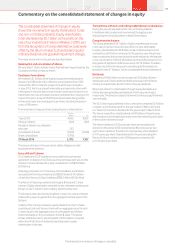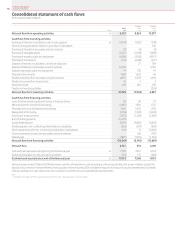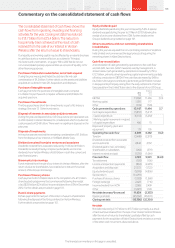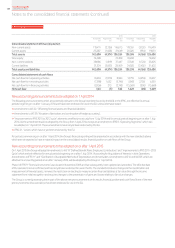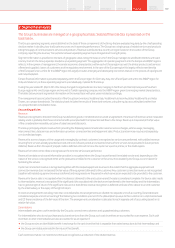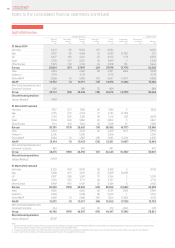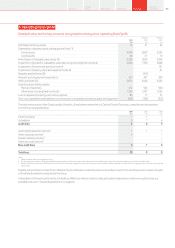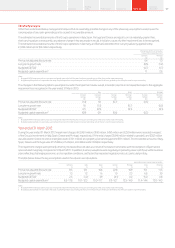Vodafone 2014 Annual Report Download - page 111
Download and view the complete annual report
Please find page 111 of the 2014 Vodafone annual report below. You can navigate through the pages in the report by either clicking on the pages listed below, or by using the keyword search tool below to find specific information within the annual report.
2. Segmental analysis
The Group’s businesses are managed on a geographical basis. Selected nancial data is presented on this
basisbelow.
The Group’s operating segments are established on the basis of those components of the Group that are evaluated regularly by the chief operating
decision maker in deciding how to allocate resources and in assessing performance. The Group has a single group of related services and products
being the supply of communications services and products. Revenue is attributed to a country or region based on the location of the Group
company reporting the revenue. Transactions between operating segments are charged at arm’s length prices.
Segment information is provided on the basis of geographic areas, being the basis on which the Group manages its worldwide interests, with each
country in which the Group operates treated as an operating segment. The aggregation of operating segments into the Europe and AMAP regions
reects, in the opinion of management, the similar economic characteristics within each of those regions as well the similar products and services
offered and supplied, classes of customers and the regulatory environment. In the case of the Europe region this largely reects membership
of the European Union, whilst for the AMAP region this largely includes emerging and developing economies that are in the process of rapid growth
and industrialisation.
Certain nancial information is provided separately within the Europe region for Germany, Italy, the UK and Spain and within the AMAP region for
India and Vodacom, as these operating segments are individually material for the Group.
During the year ended 31 March 2014 the Group changed its organisational structure, merging its Northern and Central Europe and Southern
Europe regions into one Europe region and moved its Turkish operating company into the AMAP region given its emerging market characteristics.
The tables below present segmental information on the revised basis with prior years restated accordingly.
The management basis includes the results of the Group’s joint ventures, Vodafone Italy, Vodafone Hutchison Australia, Vodafone Fiji and Indus
Towers, on a proportionate basis. The statutory basis includes the results of these joint ventures, using the equity accounting basis rather than
on a proportionate consolidation basis.
Accounting policies
Revenue
Revenue is recognised to the extent the Group has delivered goods or rendered services under an agreement, the amount of revenue can be measured
reliably and it is probable that the economic benets associated with the transaction will ow to the Group. Revenue is measured at the fair value
of the consideration receivable, exclusive of sales taxes and discounts.
The Group principally obtains revenue from providing the following telecommunication services: access charges, airtime usage, messaging,
interconnect fees, data services and information provision, connection fees and equipment sales. Products and services may be sold separately
or in bundled packages.
Revenue for access charges, airtime usage and messaging by contract customers is recognised as services are performed, with unbilled revenue
resulting from services already provided accrued at the end of each period and unearned revenue from services to be provided in future periods
deferred. Revenue from the sale of prepaid credit is deferred until such time as the customer uses the airtime, or the credit expires.
Revenue from interconnect fees is recognised at the time the services are performed.
Revenue from data services and information provision is recognised when the Group has performed the related service and, depending on the
nature of the service, is recognised either at the gross amount billed to the customer or the amount receivable by the Group as commission for
facilitating the service.
Customer connection revenue is recognised together with the related equipment revenue to the extent that the aggregate equipment and
connection revenue does not exceed the fair value of the equipment delivered to the customer. Any customer connection revenue not recognised
together with related equipment revenue is deferred and recognised over the period in which services are expected to be provided to the customer.
Revenue for device sales is recognised when the device is delivered to the end customer and the sale is considered complete. For device sales made
to intermediaries, revenue is recognised if the signicant risks associated with the device are transferred to the intermediary and the intermediary
has no general right of return. If the signicant risks are not transferred, revenue recognition is deferred until sale of the device to an end customer
by the intermediary or the expiry of the right of return.
In revenue arrangements including more than one deliverable, the arrangements are divided into separate units of accounting. Deliverables are
considered separate units of accounting if the following two conditions are met: (1) the deliverable has value to the customer on a stand-alone basis
and (2) there is evidence of the fair value of the item. The arrangement consideration is allocated to each separate unit of accounting based on its
relative fair value.
Commissions
Intermediaries are given cash incentives by the Group to connect new customers and upgrade existing customers.
For intermediaries who do not purchase products and services from the Group, such cash incentives are accounted for as an expense. Such cash
incentives to other intermediaries are also accounted for as an expense if:
a the Group receives an identiable benet in exchange for the cash incentive that is separable from sales transactions to that intermediary; and
a the Group can reliably estimate the fair value of that benet.
Cash incentives that do not meet these criteria are recognised as a reduction of the related revenue.
109Overview Strategy
review Performance Governance Financials Additional
information




